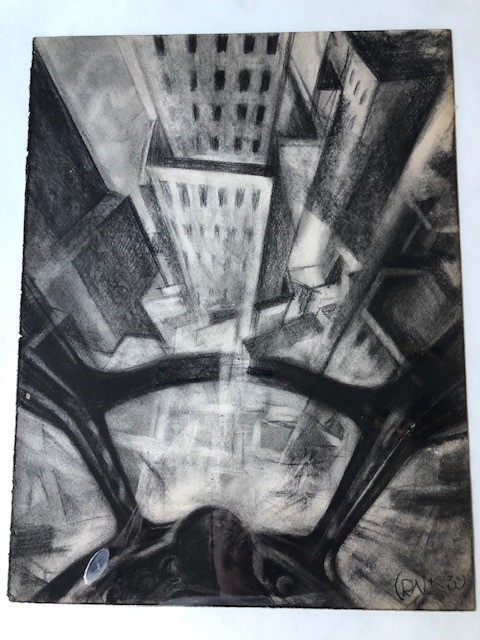TULLIO CRALI
Visual and sensory drama of flight
Prof. Francesco Carelli
For Tullio Crali (1910-2000) Futurism was not just a school of painting but an attitude to life itself. His powerful imagery reflected the movement’s unrestrained enthusiasm for the modern world, embracing technology and the machine as important sources of creative inspiration. Given its particular focus on “the immense visual and sensory drama of flight”, Crali’s work is most closely associated with the genre of ‘aeropainting’, which dominated Futurist research during the 1930s, yet he continued to explore the movement’s aesthetics throughout his life.
Reading an article about Futurism in a regional newspaper, Crali eagerly began experimenting with the movement’s aesthetics, creating his first Futurist drawing in 1925. Four years later he wrote an effusive letter to the Futurist leader, F. T. Marinetti, and received a response officially welcoming him into the movement: “Dear Futurist, delighted to have you with us in the Futurist struggle…” Initially, Crali’sstyle was influenced by a number of Futurist painters including Umberto Boccioni, Giacomo Balla and Enrico Prampolini, the latter’s semi-abstract vocabulary of sinuous lines and metallic tones being a particularly important reference point. However, by the mid-1930s the artist had developed his own distinctive interpretation of Futurism’s artistic principles. As a result of his talent, versatility and unshakable faith in the movement, Crali quickly became one of its key representatives, experimenting with a wide range of disciplines including fashion, theatre, architecture and graphic design; but it was as an aeropainter that he truly excelled.
A fascination with flight had fed into the Futurist aesthetic since the earliest days of the movement, Marinetti having identified “the sleek flight of planes whose propellers chatter in the wind like banners and seem to cheer like an enthusiastic crowd” as a paradigmatic Futurist image in his founding manifesto of 1909. This would reach its apogee with the emergence of aeropainting in 1929. Throughout the inter-war years, countless attempts were made by Futurist artists to capture not only the visual novelties experienced in flight, such as vertiginous, topsy-turvy landscapes, but also to explore its metaphysical dimensions through abstract or semi-abstract imagery intended to evoke “the transcendence of the spirit towards higher states of consciousness”. Despite incorporating recognisable details such as clouds, wings and propellers, Crali’s thrilling –and often intensely lyrical –imagery challenged conventional notions of realism by means of its dynamic perspectives, simultaneous viewpoints and effective combination of both figurative and abstract elements.
The emphasis of aeropainting would change during the late 1930s and early 1940s as this concern with the poetic aspects of aviation gave way to a greater focus on its military application in the context of contemporary events. Crali was one of a number of Futurists who participated in official war art programmes, creating images based on impressions received while accompanying pilots on combat and reconnaissance missions. Such entanglements with Mussolini’s regime damaged Futurism’s reputation in the post-war era, yet Crali was profoundly cynical about political dogma, having been a victim of ideological extremism himself. Between 1944 and 1945, his organisation of avant-garde cultural events in Gorizia led to clashes with the occupying Nazi authorities, who identified him as a subversive element and placed him on a list of individuals earmarked for deportation to Germany. Crali escaped this fate thanks to the intervention of an influential friend, only to be imprisoned in appalling conditions for 45 days by Tito’s militia before being liberated by American troops.
In early 1944, Crali had also developed an abstract form of poetry in collaboration with Marinetti, defining the principles of parole musicali (‘musical words’) in one of the final Futurist manifestos. The text encouraged poets to express themselves in the most direct manner possible by means of an instinctive use of neologisms and onomatopoeia: an ‘innovation’ that in fact implied a paradoxical return to the very origins of language, much like earlier Russian ‘zaum’ poetry. In its call for a universal language, the theory of parole musicali also contained a strikingly utopian dimension: Musical words, liberated from every literary bureaucracy, will find understanding and integration within any nation of any people of any tongue, as with any other musical work. A number of compositions written in this new style were gathered together by Crali in an intricate hand-made book. Immediately after the war –and partly in response to it –Crali moved to Piedmont where he painted a large number of works inspired not by the machine but by nature. He perceived no contradiction between this apparent shift in focus and his continuing adhesion to Futurist aesthetics, as a passage from his memoirs makes clear: My art changes form, but not substance. A lack of faith in mankind leads me to turn my attention to nature. I search out serenity in everything; I try to discover the movements of nature and to express its vitality. It is the Futurist principle of ‘universal dynamism’ that is striving to take form. There is no change of ideology. Indeed, throughout the post-war period Crali would be Futurism’s staunchest advocate. Shortly before his death in 1944, Marinetti had personally entrusted him with the task of defending both the movement’s historical significance and its continued relevance.

Photo. Charcoal, preparation for the famous painting in colors,” diving into the city”,39.

Photo: tempera, airopainting over an agricultural farm, 32

